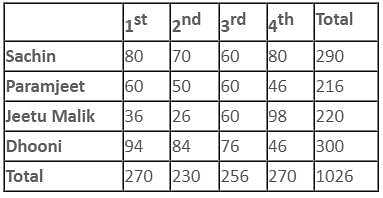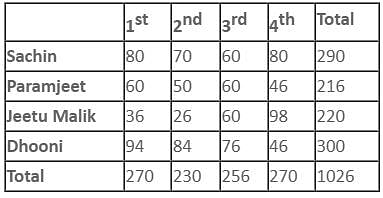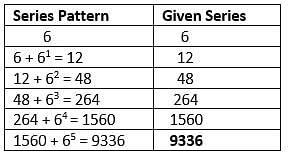VITEEE PCME Mock Test - 14 - JEE MCQ
30 Questions MCQ Test - VITEEE PCME Mock Test - 14
When the function f(x) = sin 2x(1 + cos 2x) has a maximum, one value of x is equal to
The area bounded by the curve y = x3 , x-axis and two ordinates x = 1 to x = 2 is equal to
| 1 Crore+ students have signed up on EduRev. Have you? Download the App |
If α , β are two different complex numbers such that | α | = 1, | β | = 1, then the expression | β − α /1 − α β | equals
If A, B, C are represented by 3 + 4i, 5 - 2i, -1 + 16i respectively, then A, B, C are
The area bounded by the curve y = x2 - 4x, x-axis and line x = 2 is
The solution of differential equation (xdy/dx)=y+x2 is
The degree and order of the differential equation of the family of all parabolas whose axis is x-axis are respectively
The differential equation of the family of curves y2=4a (x+a) is
If f(x) is an odd periodic function with period 2, then f(4) equals :
If tan-1x + tan-1y + tan-1z = π, then x+y+z is equal to
A function f(x) is defined as f (x) = [ 1 − x2 ] , − 1 ≤ x ≤ 1 , where [x] denotes the greatest integer not exceeding x. The function f(x) is discontinuous at x = 0 because
Directions: Study the table carefully and answer the given question.
The following table shows the number of students in different engineering departments at seven IITs. Some of the data is missing from the table.
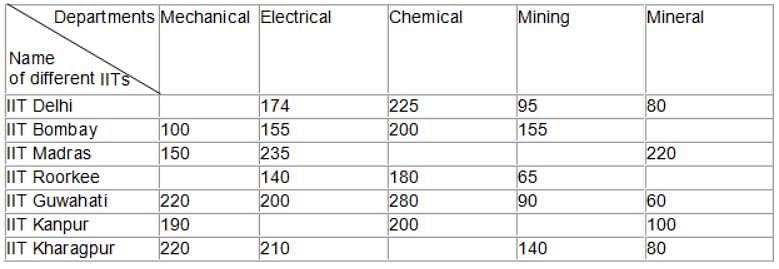
The above table is given for year 2014. In 2015, the intake of Mechanical Engineering at all the IITs together was increased by 10%, intake of Mineral Engineering was increased by 10% and intake of Chemical Engineering was increased by 8%. The intake of other departments remained the same as that of previous year.
Q. In 2014, all the students (in case total number of students was 55 or less) or only top 55 students from every department at each IIT received a scholarship of Rs. 2000. Out of the remaining, all the students (in case number of remaining students was 45 or less) or only the next 45 students from every department at each IIT received a scholarship of Rs. 1200. What is the total amount of scholarship awarded to students studying in Mining Engineering department at all the IITs together in 2014, if the total number of students in Mining Engineering at all the IITs together in 2015 was 600?
Directions: Study the table carefully and answer the given question.
The following table shows the number of students in different engineering departments at seven IITs. Some of the data is missing from the table.
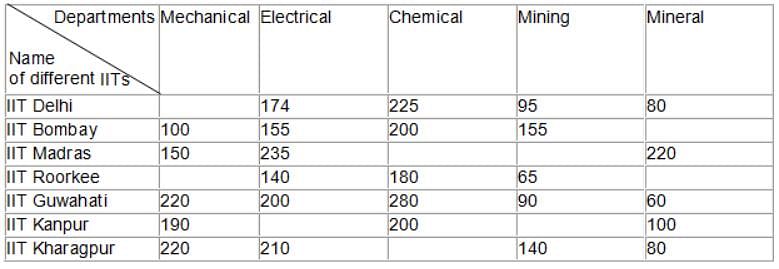
The above table is given for year 2014. In 2015, the intake of Mechanical Engineering at all the IITs together was increased by 10%, intake of Mineral Engineering was increased by 10% and intake of Chemical Engineering was increased by 8%. The intake of other departments remained the same as that of previous year.
Q. What was the ratio of the total number of students in Mechanical Engineering at IIT Delhi and IIT Roorkee in 2014, if the total number of students in Mechanical Engineering at all the IITs in 2014 was 50% more than the total number of students at IIT Delhi in 2015 and IIT Delhi had 29 students more in Mechanical Engineering as compared to Mechanical students at IIT Roorkee in 2014?
Directions: The following table shows some incomplete information about the runs scored by four batsmen in four innings.
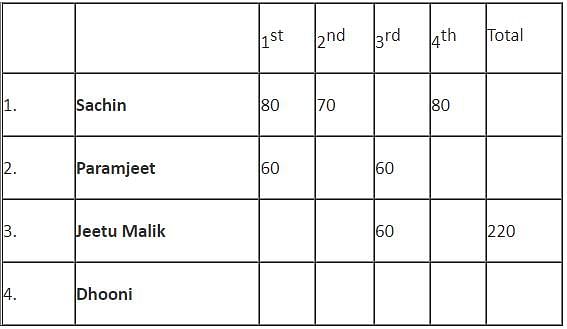
Additional information:
1. Average runs scored in the 1st innings for all the players were 67.5.
2. Paramjeet's average runs for all 4 innings were 1.5 times the runs scored by Jeetu in 1st innings.
3. Sachin's average runs were 72.5 in all four innings.
4. Total runs scored by Dhooni in all the four innings were 300.
5. The runs scored in 2nd innings were 10 less than the runs scored in 1st innings for all the players.
6. Paramjeet and Dhooni scored the same runs in 4th innings.
7. Sum of runs scored by all the players in the 4th innings is 270.
Q. Who scored the least in the 2nd innings?
Directions: The following table shows some incomplete information about the runs scored by four batsmen in four innings.

Additional information:
1. Average runs scored in the 1st innings for all the players were 67.5.
2. Paramjeet's average runs for all 4 innings were 1.5 times the runs scored by Jeetu in 1st innings.
3. Sachin's average runs were 72.5 in all four innings.
4. Total runs scored by Dhooni in all the four innings were 300.
5. The runs scored in 2nd innings were 10 less than the runs scored in 1st innings for all the players.
6. Paramjeet and Dhooni scored the same runs in 4th innings.
7. Sum of runs scored by all the players in the 4th innings is 270.
Q. Who scored the lowest runs in the 1st innings?
1 ’s are given 100 times, 2 ’s are given 100 times and 3’s are given 100 times. Now numbers are made by arranging these 300 digits in all possible ways. How many of these numbers will be perfect squares?
Find the remainder when 73 * 75 * 78 * 57 * 197 * 37 is divided by 34.
Four bells ring together and ring at an interval of 12 sec, 15 sec, 20 sec, and 30 sec respectively. How many times will they ring together in 8 hours?
Look at this series: 53, 53, 40, 40, 27, 27,...so on. What number should come next?
Look at this series: 4, 11, 19, 41, ?, 161...so on. What number should come?
Look at this series: 6, 12, 48, 264,1560...so on. What number should come next?


